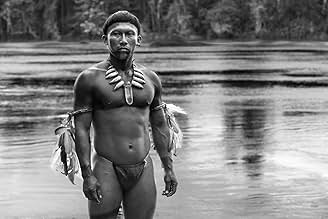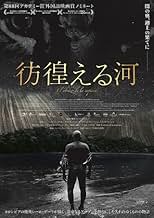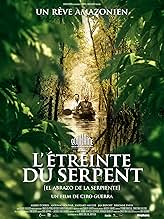Die Geschichte der Beziehungen zwischen Karamakate, einem Schamanen aus dem Amazonasgebiet und letzten Überlebenden seines Volkes, und zwei Wissenschaftlern, die mehr als 40 Jahre lang gemei... Alles lesenDie Geschichte der Beziehungen zwischen Karamakate, einem Schamanen aus dem Amazonasgebiet und letzten Überlebenden seines Volkes, und zwei Wissenschaftlern, die mehr als 40 Jahre lang gemeinsam versuchten, am Amazonas eine geweihte Heilpflanze zu finden.Die Geschichte der Beziehungen zwischen Karamakate, einem Schamanen aus dem Amazonasgebiet und letzten Überlebenden seines Volkes, und zwei Wissenschaftlern, die mehr als 40 Jahre lang gemeinsam versuchten, am Amazonas eine geweihte Heilpflanze zu finden.
- Für 1 Oscar nominiert
- 46 Gewinne & 32 Nominierungen insgesamt
- Old Karamakate
- (as Tafillama-Antonio Bolívar Salvador)
- Manduca
- (as Yauenkü Miguee)
- Borracho Cohiuano
- (as Jesús Rodríguez)
Empfohlene Bewertungen
The film, in which nine different languages are spoken, follows two interconnected stories based on the travel journals of two Amazonian explorers thirty years apart, German scientist Theodor Koch-Grunberg (Jan Bijvoet, "Borgman") and American plant enthusiast Richard Evans Schultes (Brionne Davis, "Avenged"). Both men are seeking the Yakruna plant to discover its powerful ability to heal. The two explorers are accompanied by the Amazonian shaman Karamakate (Niblio Torres as a young man and Antonio Bolivar as the elder) not only to find the sacred plant for research purposes but to learn deeper truths about themselves and the nature of reality. Karamakate, the last surviving member of his tribe, guards the secrets of Yakruna, a last symbol of independence for his people.
Filmed in black and white by cinematographer David Gallego ("Cecilia"), it is the first film to be shot on location in the Amazon in thirty years and its gorgeous kaleidoscope of rivers and forests, and the blending of time creates a surreal, dreamlike atmosphere, fortified by native songs and chants. As the film begins, a young Karamakate, armed with a spear and dressed in native attire, stands menacingly as a boat approaches the shore containing the German scientist and his companion Manduca (Yauenku Migue), a native dressed in white man's clothing.
Manduca asks the shaman to cure the explorer who is very sick, but Karamakate, who is familiar with the destructive nature of the white man, refuses. When Theo tells him, however, that he has seen survivors of his people and will take him to them, the young shaman agrees as long as the white man follows his "prohibitions" about disturbing the natural flow of the jungle. The two scientists, Theo in 1909 and Evan in 1940, follow the same path and explore the same places drastically changed over the years. Karamakate, as he did with Theo, acts as Evan's guide and considers himself as a "chullachaqui," an empty shell of a human being, and must become a man once more in tune with nature.
Two scenes stand out. After a night of singing and dancing with a native group and demonstrating Western technology, Theodor becomes angry when a member of the group wants to keep his compass in exchange for goods. To rationalize his anger, he tells Karamakate that owning a compass would disturb their traditions of finding locations through the sun and stars, but the shaman tells him "You cannot forbid them to learn. Knowledge belongs to all men." The other scene is one of pure horror when a priest (Luigi Sciamanna, "Secreto de Confesion") at a Spanish mission is found brutally whipping his young students until Theodor intervenes.
Despite an element of religious madness that feels out of sync with the tone of the film, Embrace of the Serpent soars when its focus is on spiritual awareness. The shaman tells both scientists the need to unburden themselves of their material possessions and explore the mystery of consciousness alone without their physical and psychological baggage. They cannot be cured of their illness, he tells them, because they have forgotten how to dream. After Evan ingests a native plant following a heated exchange with Karamakate, a montage of brilliant, swirling colors pushes the boundary of what we think is real and allows us to remember how to dream.
Embrace Of The Serpent is one such cinematic experience which brought a deserved Academy Award Nomination . Ecological thriller that has in highlighting the destruction of the South American rain woods by the rubbers ; being based upon a real story , on diaries by scientists Theodor Koch-Grunberg and Richard Evan Schultes , both of whom delve into the Amazonian rainforest in search of a rare plant with medicinal and hallucinatory qualities, with the assistance of a local shaman on opposite ends of his own life journey . An ecological adventure with mystical touches that was ahead of its time in denounce about forest destruction , including some disconcerting scenes , as the frames where a man is praised to be the Messiah is based on an actual event . Embrace of the Serpent attempts to frame the destruction of the rain forest's ecology and peoples as a slow-motion tragedy on scales both personal and cultural , but it is more intriguing in its ambitions, which frustrate it, than in it successes, which are limited . This exciting film contains thrills , emotion , adventure and marvelous scenes from deep rainy forest that generate a lot of surprises and illusion . This film has got some images "stuck in their head" including several sequences can stay in your brain for a long, long while .
Glamorous and lush cinematography by David Gallego who photographs wonderfully the Amazon jungle , obviously filmed under difficult conditions on location . Shot in black-and-white, which is at once visually distinctive but also rather flattening . Evocative musical score by Nascuy Linares and the music Evan plays on the gramophone is Haydn's "The Creation". This engrossing and enjoyable film with interesting screenplay by Ciro Guerra and Jacques Toulemonde Vidal was well directed by Ciro Guerra . He's a good professional filmmaking giving various Colombian successes such as Los Viajes Del Viento (2009) and La Sombra Del Caminante (2004) . Rating "Embrace of the Serpent" : Better than average . Wholesome watching .
Karmakate is the last survivor of his tribe, living in the heart of the Colombian Amazon. At two separate points in time, he is asked by foreign scientists' Theodor Koch-Grunberg and Richard Evan Schultes -- both with different purposes -- on how to find a scared healing plant. The film borrows a lot of its content from their diaries from when they had commissioned Karmakate to help them in 1909 and 1940, respectively. He is conflicted as he has no ambition to help "the White man" because his tribe was wiped from the Earth by them, and he lives his days by himself.
The film doesn't beat around the bush. As it progresses, it becomes evident that the story is about the devastation of colonialism and what it had done to the land & its people. Everything from spreading Catholicism to Rubber Farming, more and more they see the land changing for the worse.
It was impressive to not only hear these actors speaking Spanish, but also being able to converse in the native tongue of the locals, including the several other languages that were used through out the film. Couple that with the beautiful cinematography, and you have yourself quite the masterpiece.
Fans of Miguel Gomes' 'Tabu' would likely enjoy this. Shot in black and white. Beautiful transitions and landscape shots. Winner of the Art Cinema Award at Cannes. Expect this film to go for Best Foreign Film at the Oscars.
Wusstest du schon
- WissenswertesThe scene where a man is praised to be the Messiah is based on an actual event.
- Zitate
Young Karamakate: Knowledge belongs to all. You do not understand that. You are just a white man.
- VerbindungenFeatured in Starfilm (2017)
- SoundtracksEmbrace Of The Serpent
(Theme from Original Motion Picture Soundtrack)
by Nascuy Linares
© 2016 Plaza Mayor Company, Ltd.
Top-Auswahl
- How long is Embrace of the Serpent?Powered by Alexa
Details
- Erscheinungsdatum
- Herkunftsländer
- Offizielle Standorte
- Sprachen
- Auch bekannt als
- Embrace of the Serpent
- Drehorte
- Produktionsfirmen
- Weitere beteiligte Unternehmen bei IMDbPro anzeigen
Box Office
- Budget
- 1.400.000 $ (geschätzt)
- Bruttoertrag in den USA und Kanada
- 1.329.249 $
- Eröffnungswochenende in den USA und in Kanada
- 50.955 $
- 21. Feb. 2016
- Weltweiter Bruttoertrag
- 3.217.212 $
- Laufzeit2 Stunden 5 Minuten
- Farbe
- Sound-Mix
- Seitenverhältnis
- 2.35 : 1
Zu dieser Seite beitragen














